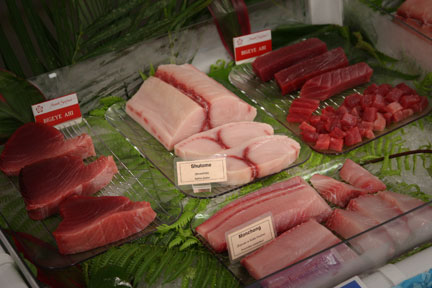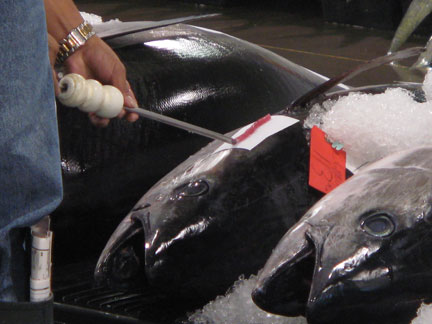Seafood Safety

Download the Seafood Safety Booklet “Keeping Hawaii Seafood Safe to Eat”
Fresh island seafood is one of things that makes living in Hawaii so special. One of the top priorities of the Hawaii fishing and seafood industry is to make sure that our seafood is safe to eat. It’s the responsible thing to do. Safe and wholesome local seafood is vital for a healthy nutritious diet for the people of Hawaii and others that enjoy Hawaii Seafood.
Keeping it Safe
It is widely accepted that there are health benefits from including more fish in the diet. There is strong evidence that the health benefits by far outweigh the risks of eating most types of seafood. However, seafood safety is a growing concern. Fortunately, there are only a few food safety hazards associated with certain types of seafood products among the many varieties available. Understanding the potential food safety risks and weighing them against the known benefits is the key to prevention.

Inspections, Regulated by the U.S. Government
The U.S. government responded to the increased concern over seafood safety by implementing a new mandatory seafood inspection program in late 1997.
The U.S. FDA Seafood HACCP Regulation requires all seafood processors (domestic and overseas) and importers to implement HACCP-based seafood safety systems aimed at preventing specific seafood-related illnesses. HACCP which stands for Hazard Analysis Critical Control Point is a commonsense, science-based and methodical approach to food safety.
The HACCP approach depends on understanding the potential hazards, devising effective control measures, and monitoring critical steps in the harvesting and processing of seafood to control the hazard. HACCP is not a zero-risk system, but instead aims to minimize the risk of seafood safety hazards that are reasonably likely to occur.
Hawaii is a leader in the development and implementation of evidence-based seafood safety controls related specifically to our kinds of fish and our fishing and seafood operations. Interactively browse “Keeping Hawaii Seafood Safe to Eat” by clicking on the image to the left. Or click here to download the pdf version.
Additional Information on Seafood Safety
Kaneko, J.J. and L.B. Medina. 2009. Risk of Parasitic Worm Infection from Eating Raw Fish in Hawaii: A Physician’s Survey. Hawaii Medical Journal 68:227-229.
WHY THIS PAPER IS IMPORTANT: The growing popularity of eating raw fish as sashimi and sushi in the US has raised questions about the risk of parasites. There are no records of parasite infections from raw consumption of Hawaii fish species that are commonly and traditionally eaten raw. Hawaii physicians were surveyed to determine if cases are being diagnosed, but not reported. No unreported cases involving Hawaii fish species were uncovered. Most physicians surveyed eat raw tuna and skipjack and do not believe there is a significant parasite risk.
Click to download full article.

Kaneko, J.J. and P.K. Bartram. 2009. Mercury in Seafood: Is Hawaii Seafood Safe? Updated July 15, 2009. PacMar Inc. under NOAA Award No. NA06NMF4520222. 16 p.
WHY THIS PAPER IS IMPORTANT: This paper addresses some of the concerns about mercury in fish by presenting relevant scientific evidence. It is prepared in a question and answer format to discuss mercury in the environment, mercury poisoning events, the protective effects of selenium and the basis of the current mercury in fish guidance.
Click to download full article.
Kraepiel, A.L., K. Keller, H.B. Chin, E. Malcolm and F.M. Morel. 2003. Source and Variations of Mercury in Tuna. Environmental Science & Technology 37 (24):5551-5558.
https://www.geosc.psu.edu/~kkeller/Kraepiel_est_03.pdf
WHY THIS PAPER IMPORTANT: There is a common assumption that mercury in tuna is from industrial pollution. This study found that while atmospheric mercury emissions increased by 26%, the mercury level in Hawaii yellowfin tuna did not change between 1971 and 1998. It was concluded that because elemental mercury in the atmosphere must be methylated by bacteria under anoxic conditions before ending up in tuna as methylmercury, that the conversion is most likely a deep ocean process. The study concludes that methylmercury in Hawaii tuna is from natural environmental background and not directly from atmospheric pollution.
Ralston, N.V.C., J.L. Blackwell III and L.J. Raymond. 2007. Importance of Molar Ratios in Selenium-Dependent Protection Against Methylmercury Toxicity. Biological Trace Element Research 119 (3): 255-268.
Article DOI: 10.1007/s12011-007-8005-7
https://www.springerlink.com/content/a1456r4233v4tnm4/?p=1ac412a801dd429cb87a68f51abe4df2&pi=6
WHY THIS PAPER IS IMPORTANT: Although the protective effects of selenium on mercury toxicity have been demonstrated in every animal model studied since the 1960s, this knowledge has been largely ignored in risk assessments of mercury in seafood. This paper discusses the importance of selenium mercury interactions. Selenium binds with mercury creating a biologically inert compound. With advancements in understanding of selenium’s essential functions, it is now more likely that mercury toxic effects are due to selenium sequestration, selenium deficiency and loss of selenium-dependent anti-oxidant functions in the brain. Foods that deliver an excess of selenium over mercury provide net selenium health benefits. Those that contain an excess of mercury may be associated with mercury health risks.
Kaneko, J.J and N.V.C. Ralston. Selenium and Mercury in Pelagic Fish in the Central North Pacific Near Hawaii. Biological Trace Element Research 119(3):242-254.
Article DOI: 10.1007/s12011-007-8004-8
https://www.springerlink.com/content/a7t6506062k1008p/?p=1ac412a801dd429cb87a68f51abe4df2&pi=5
WHY THIS PAPER IS IMPORTANT: Mercury is toxic at high concentrations, but its toxicity at the levels found in open ocean fish remains uncertain. Numerous studies confirm that health benefits of eating seafood far outweigh the effects of low levels of mercury. Selenium’s protective effects against mercury toxicity have been known since the 1960s. For this reason, the relative amount of selenium and mercury in fish is an important risk factor. This study found that 13 out of 15 species of open ocean fish contain a molar excess of selenium over mercury. Swordfish contained equal molar amounts of selenium and mercury. Only mako shark contained an excess of mercury over selenium. Hawaii’s most common open ocean fish species contain an excess of selenium and are more likely to prevent mercury toxicity than cause it.
Kaneko, J.J., J.W. Bell and D.R. Hawn. 2004. Verification of a HACCP-based Strategy for the control of histamine for the fresh tuna industry. Project Final Report. NOAA Award No. NA16FD2472. PacMar, Inc., Honolulu, Hawaii. 47 p.
WHY THIS PAPER IS IMPORTANT: Histamine poisoning is one of the leading seafood related illnesses in the US. It is preventable with safe fish handling practices that rapidly cool fish to prevent bacterial growth. Safe fish handling from the fishing vessel to the consumer is essential. The initial handling period at sea is the most critical and difficult to manage. This study documented fish cooling rates and efficacy of histamine control under standard fish handling practices and storage in ice on board Hawaii longline fishing vessels. Sensory examination of fish for spoilage odors at the time of delivery was highly effective in culling fish containing high histamine levels. Careful inspection on shore, coupled with standard operating procedures for safe fish handling at sea provides effective control of histamine.

